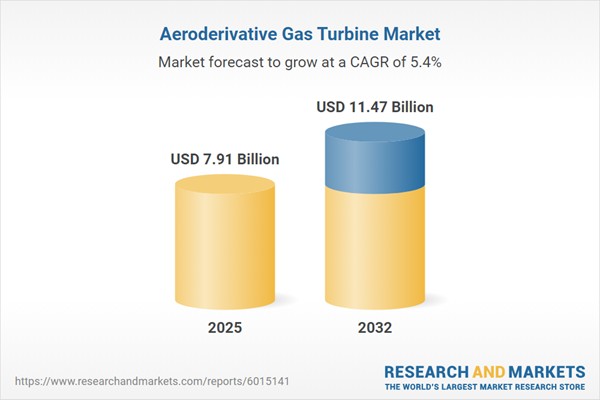Speak directly to the analyst to clarify any post sales queries you may have.
Senior energy leaders are advancing investment and operational strategies to stay ahead of rapid shifts in power generation markets. The aeroderivative gas turbine market now plays a pivotal role, giving organizations a critical edge as they respond to evolving regulatory environments, reliability needs, and global supply chain pressures.
Market Snapshot: Aeroderivative Gas Turbine Market Size and Growth Trajectory
The global aeroderivative gas turbine market is valued at USD 7.50 billion in 2024, with expectations to reach USD 7.91 billion in 2025 and a projected USD 11.47 billion by 2032, based on a compound annual growth rate (CAGR) of 5.44%. This growth reflects a steady progression toward distributed and decentralized energy solutions across multiple sectors. Widespread use in marine, oil and gas, and utilities underscores how macro-level trends—such as decarbonization, grid modernization, and the drive for operational flexibility—are transforming market dynamics. As organizations prioritize resilience and adaptability, aeroderivative gas turbines emerge as fundamental to future-ready energy infrastructure.
Scope & Segmentation of the Aeroderivative Gas Turbine Market
This report provides detailed segmentation to support robust strategy, risk management, and precision investment for senior decision-makers:
- Application: Covers marine transport, oil and gas operations, and power generation, analyzing demands for rapid power deployment, shipping optimization, and reliable infrastructure.
- Power Output Range: Details turbine categories by output below 20 MW, from 20–40 MW, and above 40 MW, helping organizations meet regulatory criteria and project-specific goals.
- End User: Assesses needs of independent power producers, utilities, and industrial clients, exploring trends in procurement approaches, scaling capabilities, and asset lifecycle planning.
- Fuel Type: Looks at application of distillate fuel oil, dual-fuel systems, and natural gas, providing insights for emissions management and supply reliability planning.
- Technology: Examines the deployment of single-shaft and two-shaft turbines, focusing on adaptability and performance for varied operational conditions.
- Installation Mode: Differentiates between land-based and offshore implementations, addressing logistics, regional infrastructure, and geographic requirements.
- Regional Coverage: Reviews market activity and regulatory influences across Americas, Europe, Middle East & Africa, and Asia-Pacific, allowing for tailored regional strategies and competitive positioning.
- Company Analysis: Profiles major industry participants including General Electric Company, Siemens Energy AG, Rolls-Royce plc, Mitsubishi Heavy Industries, Solar Turbines, Pratt & Whitney, Kawasaki Heavy Industries, MTU Aero Engines AG, Ansaldo Energia, and IHI Corporation, with a focus on technology pathways and market strategies.
Aeroderivative Gas Turbine Market: Key Takeaways for Senior Decision-Makers
- Aeroderivative turbines enhance grid agility through reliable cycling capabilities and seamless integration with renewable energy systems.
- Advancements in materials and deployment of real-time analytics enable asset monitoring and predictive maintenance, supporting operational continuity.
- Hybrid configurations integrating storage or renewables align with evolving policy mandates and boost localized energy reliability.
- Procurement models are shifting to navigate new regulatory frameworks and manage complex supply chains, ensuring timely project delivery and compliance.
- Collaborative approaches among manufacturers, service providers, and financiers expedite technology adoption and streamline execution of large-scale energy projects.
- Modular system designs, paired with comprehensive digital analytics, allow suppliers to deliver customized efficiency, improved uptime, and greater lifecycle performance.
Tariff Impact: Reshaping Cost Structures and Supply Chains
Upcoming tariffs in the United States for 2025 are leading turbine manufacturers to revisit supply chain design and production tactics. Many firms are increasing domestic manufacturing, diversifying sourcing channels, and adopting flexible contract terms. These adaptive strategies help control costs and keep project timelines on track amid shifting trade landscapes and volatile global dynamics.
Methodology & Data Sources
The research combines analysis of technical publications, reviews of patent and regulatory documentation, and interviews with executive stakeholders. All insights are validated by domain specialists to provide a trusted foundation for strategic decisions.
Why This Report Matters
- Offers actionable segmentation and strategic intelligence for effective market entry, capacity expansion, and competitive positioning.
- Supports senior leaders in proactively navigating operational and supply chain complexity to maximize energy asset value.
- Helps organizations allocate capital with agility and adapt to changing market and regulatory frameworks, building long-term resilience.
Conclusion
Senior decision-makers gain a comprehensive intelligence resource in this report, supporting investments and operational strategies that keep aeroderivative gas turbine market initiatives aligned with new sector standards and future expectations.
Additional Product Information:
- Purchase of this report includes 1 year online access with quarterly updates.
- This report can be updated on request. Please contact our Customer Experience team using the Ask a Question widget on our website.
Table of Contents
3. Executive Summary
4. Market Overview
7. Cumulative Impact of Artificial Intelligence 2025
Companies Mentioned
The companies profiled in this Aeroderivative Gas Turbine market report include:- General Electric Company
- Siemens Energy AG
- Rolls-Royce plc
- Mitsubishi Heavy Industries, Ltd.
- Solar Turbines Incorporated
- Pratt & Whitney
- Kawasaki Heavy Industries, Ltd.
- MTU Aero Engines AG
- Ansaldo Energia S.p.A.
- IHI Corporation
Table Information
| Report Attribute | Details |
|---|---|
| No. of Pages | 199 |
| Published | October 2025 |
| Forecast Period | 2025 - 2032 |
| Estimated Market Value ( USD | $ 7.91 Billion |
| Forecasted Market Value ( USD | $ 11.47 Billion |
| Compound Annual Growth Rate | 5.4% |
| Regions Covered | Global |
| No. of Companies Mentioned | 11 |









